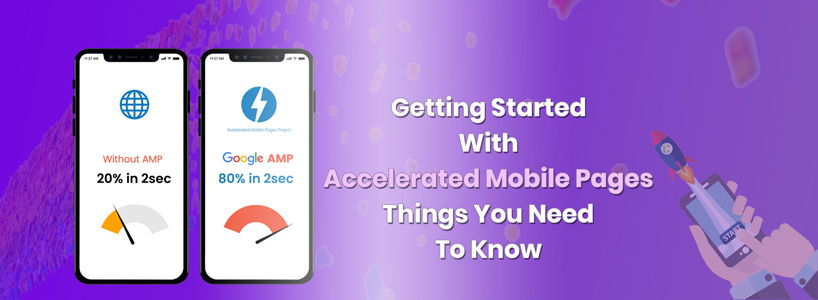2015 saw the breakthrough development in content delivery and publishing when Google launched its flagship project Accelerated Mobile Pages. In October 2018, Google AMP celebrated its three-year anniversary stating that it is now powering billions of web pages over tens of millions of domains in the World of Web. Many publishers and other businesses like e-commerce have seen lucrative outcomes by implementing AMP for their content delivery. While many talked about the minimization of bounce rate and increased click through rate, there were others who sang praises by stating the huge returns on investment it has garnered as Ad revenue. There are many other positive metrics that are being witnessed by companies implementing AMP for their websites. If getting AMP pages for your website is on your mind, here is a blog that will get you started.
AMP: A Quick Understanding
Accelerated Mobile Pages aka AMP is the buzzword in the tech world today. Being a Google initiative launched in 2015, this project has taken the digital world by storm. Although not being an official factor for search engine ranking, Google AMP enhances the user experience on any website by boosting speed; thus, having a substantial effect on SEO. And we all know that Google algorithms do use user-experience and speed as a ranking factor, especially for the mobile search queries. Briefly speaking, AMP is an open-source initiative by Google to make web pages load instantly and make the web a better place for all its users. Moreover, Accelerated Mobile Pages keep in mind the need to monetize a site and ensure that the site owner is still able to fetch maximum revenue from Ads.
The Working of AMP
The HTML web components available in the open source library offered by Google Accelerated Mobile Pages make it easier for publishers to create web pages or websites that are super fast to load. Google creates caches of these pages on its Content Delivery Network and as soon as a user enters a similar query, it instantly pre-fetches the page and offers an instant loading. Creating Accelerated Mobile Pages for your website takes place in three parts. These are:
- Asynchronous Execution of AMP JavaScript Accelerated Mobile Pages ensure that JavaScript does not delay the page rendering and thus execute JavaScript asynchronously. When there are any interactive page features, AMP custom elements come into play for instant loading. No third-party JavaScript is permitted with AMP. The AMP JS eliminates any chances of delays in page loading by managing resource handling.
- Flawless Adaption To AMP HTML This Google Project has its own subset of the HTML markup language, i.e., AMP HTML. This open-source code comes to assistance when creating AMP pages. It comes with individual tags for customization and various other properties to ensure the pages are loaded without any issue. There are various restrictions as well in AMP HTML like only inline styles are allowed in AMP pages. There are many tags in AMP HTML that are changed a bit to sync with the components of Accelerated Mobile Pages. In order to make Accelerated Mobile Pages, it is important to have a flawless adaption to AMP HTML for page creation.
- Instant Loading With AMP CDN In order to ensure quick and instant loading of Accelerated Mobile Pages on the browser of the user, there is an optional Content Delivery Network, named AMP CDN. The content delivery network, AMP CDN, is built while especially considering the AMP pages. Although it does not come to assistance during the creation of AMP pages, it plays a crucial role in the working of Accelerated mobile Pages. Google can easily cache the AMP pages on this AMP CDN that allows partial loading of pages beforehand to allow quick prefetching and instant loading when a user enters a similar query. This ensures an optimized performance of the pages on fetching.
How To Set Up AMP
To set up AMP for your page, it is important to create two versions of the same; one would be the regular web page that would load on any device, the second would be the Accelerated Mobile Page version. To set up an AMP version, things like rewriting the site templates, requirement of special amp-font extensions, special handling of multimedia, addition of custom tags for embedding videos/images, etc. Many might feel that just creating a multimedia version would suffice but in reality, two versions are required for setting up AMP so that the AMP version can also be detected and indexed by Google.
Monetizing With AMP
A question that most publishers ask regarding AMP pages is whether they would be able to fetch as much revenue through monetization or not. The simple answer lies in the fact that many publishers have experienced over $6 million earning per week through the ads running on their AMP pages and even experiencing 3 times more revenue. In fact, while launching the Google AMP project, it was stated that the main aim of AMP is to optimize monetization by enabling instant loading of ads on the pages. The ads on AMP load as instantly as the content on the page, thus increasing the chances of getting click impressions for higher revenue.
Apart from that, Google Accelerated Mobile Pages are also lined with various analytics that is not just smart in measuring the performance of the site but also ensures that the analytics elements do not slow down the site. In a nutshell, by creating an AMP version of your website, you cannot just improve your site speed and optimize the user experience, but also boost sales and track the user actions for better performance.


1 thoughts on "Getting Started With Accelerated Mobile Pages: Things You Need To Know"
NotifyVisitors
13 June, 2019 at 7:53 am
Awesome blog on AMP! Thanks for sharing detailed info.
Cancel
Reply